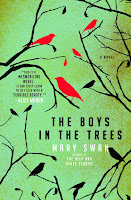 After finishing Mary Swan’s Giller-nominated novel, The Boys in the Trees, this morning I started again from the beginning, flipping through passages and re-reading the first few chapters because I was not the least bit ready for the book to be finished. The structure of the novel is unique, the bits and pieces of the lives of the main characters, William Heath and his family, are sewn together slowly by alternating points of view in and outside of the family.
After finishing Mary Swan’s Giller-nominated novel, The Boys in the Trees, this morning I started again from the beginning, flipping through passages and re-reading the first few chapters because I was not the least bit ready for the book to be finished. The structure of the novel is unique, the bits and pieces of the lives of the main characters, William Heath and his family, are sewn together slowly by alternating points of view in and outside of the family.
The novel starts off with a young William running from an awful home life and hiding up in the trees. A view that allows both the boy his imagination and us foreshadowing for only trepidation should set in when characters boldly state, “…that one day people would know his name.” The narrative shifts forward in time to William with his family in London, to illness, to their emigration to Canada, to hard times, and then the book takes their perspective away and starts handing it to other people.
To Sarah and Alice, spinster-sisters, the latter a temperance worker who stumps for her cause and the former, a school-teacher who has Heath’s two remaining children in his classroom. From here we move to Dr. Robinson’s point of view, through his ex-servant Abby, to Eaton, the doctor’s son, much older now and well removed from the tragedy. The action that forms the impetus for the heinous act that no one truly understands: why William commits the crime that he does, and the ramifications of his actions.
It’s a swift, sure-footed novel that talks around the main action, spares the reader the gory bits, but discusses the implications regardless. Set just before the turn of the century, it’s also a picture of immigrant life, of the harsh nature of what it meant to leave everything behind and still find your life no better. I think the part of the novel that captured my attention, the two characters I would have liked to have spent a bit more time with, were the two sisters, and I’d happily read an entire book about the pair.
Swan’s writing style reminded me a little of Richard Wright’s Clara Callan, not that it’s epistolery, but rather the idea of indirect story telling and how effective it can be when done with a delicate grace. On a personal note, the book also gives me hope for my own novel, in the sense that I’ve been hearing plenty of industry talk that there’s too much fiction coming out of Canada with the same themes of “death, immigrant experience and back to the land.” Even if we, as a collective writerly conscious, move in similar ways, it’s still possible, as Mary Swan has shown, to create something hauntingly original.
READING CHALLENGES: I’m counting The Boys in the Trees towards my 2008 Canadian Book Challenge. I’m seven books in with six more to go by July 1st. I am confident that I’ll make it.
WHAT’S UP NEXT: The tally for the 2008 Race to the Finish Line Reading Stack so far: “Here’s my stack: “A Christmas Carol, The Other Queen, The Given Day, The Plot Against America, Lush Life, Through Black Spruce, The Origin of Species, The Boys in the Trees, The Double, The Almost Moon and Middlemarch.” I’m not sure where I’ll go next, but it’ll be something from the above list.”
READING COMPS: Clara Callan, Afterimage, Effigy. This is also a novel I would recommend to my friend Sam.
I loved this story too. I’m not surprised it was nominated. I’m doing the Canadian Reading Challenge too but got bogged down on writing reviews after the sixth one. Through Black Spruce was great, I thought. And I intend to read Origin of the Species, The Given Day, and The Double (I assume you mean Dostoevsky) also. Great review. Take care of yourself.
I maintain that Boys… should have won the Giller. Not just because I lost money on it…